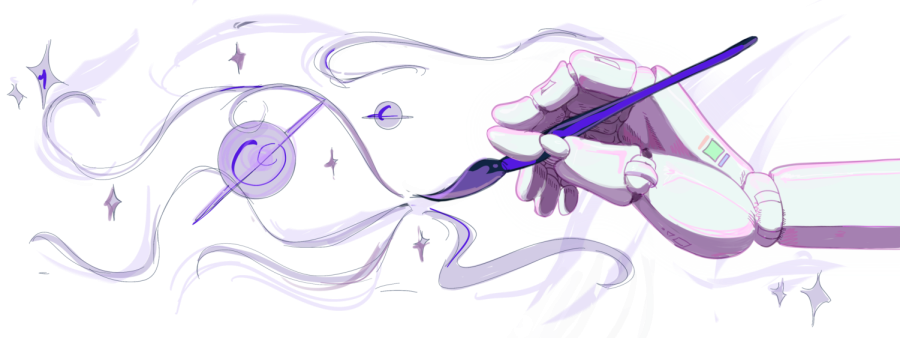The Rise of STEAM
Letting go of the pressure to choose between Art and STEM by defying the expectation to choose a traditional career path
As students approach their ever-looming graduation, the pressure of finding a path to pursue begins to pile up, creating a bundle of stress and burden. This is a familiar concept for many students at Paly, but even more so for those choosing to pursue contrasting subjects: STEM versus art.
Renny Argast, a Paly junior passionate about art, feels trapped by the division of these two categories.
“It is very stressful because I have to balance my time between art and STEM, as I value my grades over my personal endeavors,” Argast said. “As for my future, a major in arts is looking more and more unstable as I get older.”
This feeling of uncertainty comes mostly from how difficult and strenuous starting and keeping a steady job in the arts is. These worries accumulate a tremendous amount of pressure on aspiring artists.
For Argast, choosing to pursue art in the future feels like a leap of faith.
“People put a lot of value on having a stable income, which is important but it is not the most important thing,” Argast said.
The instability students feel is also brought on by the social pressures associated with living in Silicon Valley. Living in the heart of technology in the country comes with an intense focus on the STEM fields. Many students feel pressure to excel in challenging STEM classes and extracurricular pursuits as opposed to arts-related classes in order to ensure a successful future ahead.
Vivan Trach, a Paly senior involved in a girls robotics team, is one of the many students who have first-hand experience with the narrow-minded school culture.
“Culturally, art has a big influence and it is vital, but it is easily overlooked because art is more like a quality of life improver and many people may not see that as important as [curing] cancer,” Trach said.
This normalized myth that artists have a pointless role in society is deeply embedded within our society. Not only have students submitted to this culture, but parents also have this ideology of linking art to failure.
With such immense parental expectations, students often feel the need to meet and exceed them. Living in a place known for its work with technology, it is not a surprise that many students such as senior Caleb Chan have parents in more STEM-related fields.
“Both my parents are in STEM so it’s something I’ve always been around and [followed] along, like engineering,” Chan said.
Another factor that further complicates one’s ability to choose a career path is the issues surrounding gender stereotypes in STEM. Typically, we see STEM represented by men in the media and often viewed as a masculine subject while women are underrepresented for their STEM abilities and potential.
These gender stereotypes lower girls’ self-confidence and interest in pursuing STEM careers.
“Although I definitely can major in computer science…I despise the misogyny, sexism and the guys in computer science, and that’s the only reason why I am not majoring in [it],” Trach said. “That’s a big deterrent.”
Even if women choose to pursue STEM-focused careers or majors, there is a stigma that they are inclined to take specific STEM disciplines – particularly soft sciences rather than hard sciences.
“A lot of people tend to assume that since I am a woman, I want to do something like humanities or psychology and not something like computer science or neuroscience,” Trach said.
Although this is an issue that is still deeply embedded within our society’s culture and history, in the past decades, women have debunked the “standard norms.”
“The misogyny in STEM makes me want to one-up men and show them that women can do other sciences like data science too,” Trach said.
Men, just like women, are constricted by stereotypes and penalized if they act outside of their gender roles. For instance, many are hesitant to pursue the arts due to the fear of appearing too “feminine” or “weak.” Males are often shaped to be “strong” and “tough,” which contradict the common stereotype of artists being “emotional” and “soft.” With this misrepresentation, many men avert from pursuing an art career in fear they may be perceived as foolish.
Despite all of the negativity surrounding STEM and art, there are also many positive aspects of the intertwinement of the fields.
At first glance, painting a scenic view and solving a complex algebraic equation may seem tremendously different, but upon further evaluation of the thought process and creativity involved in both, similarities begin to arise between the two activities.
The corresponding skills required to be successful in both art and STEM activities has led people to incorporate an “A” – representing art – in STEM to create the acronym STEAM.
This change has brought many people together within both communities. Tracey Atkinson, an art teacher at Paly, believes the change is for the better and blending the subjects together will enhance both fields.
“You have to be able to solve problems, you have to be able to think and you have to know how to revise,” Atkinson said. “There really is so much overlap between the two [fields].”
Others believe that the differences between art and STEM are too great and the subjects are better off divided.
“I wouldn’t say there are rules because obviously there are not, but there is more structure [in STEM],” Chan said. “In arts you could pretty much do whatever you want whereas there is more order within STEM.”
Although everyone has different perceptions of the division or combination of STEM and art, there is one aspect they can agree they both share: pressure.
All of the pressure put on students by their parents, peers and teachers to be successful and know what they want to do with their lives is enough to make anyone feel lost.
“I think that life is complicated and you might decide in high school that you’re going to do one thing and then end up doing something totally different,” Atkinson said. “You do yourself a disservice by saying, ‘I’m only going to do this one thing.’”
Print Issue
Please click on the three vertical dots on the top right-hand corner, then select “Two page view.”

2022-2023 Staff Writer
2023-2024 Creative Director
Journalism is integral in every society across the globe as it is how people stay informed. It...

2022-2023 Staff Writer
2023-2024 Managing Editor
I joined C Mag as a way to express my creative side and advocate for subjects I am passionate about....

2021-2022 - Staff Writer
2022-2023 - Managing Editor
Pronouns: he/him







